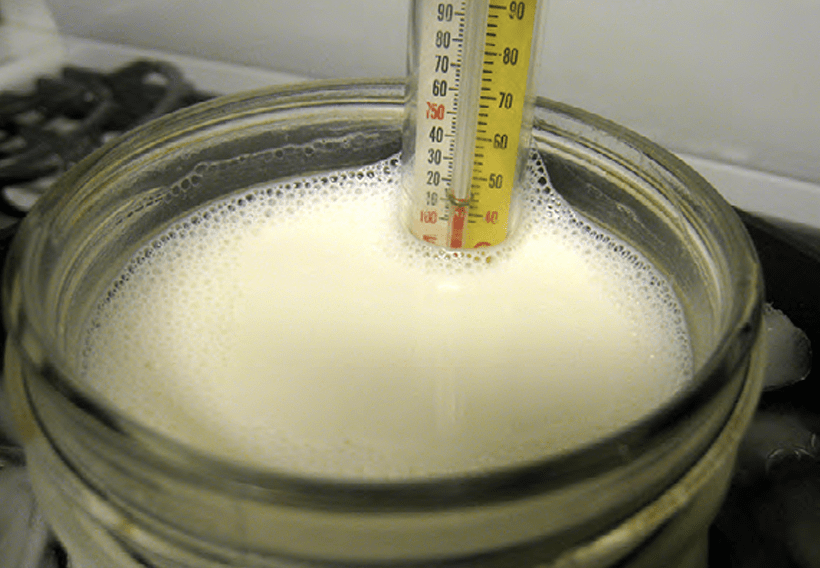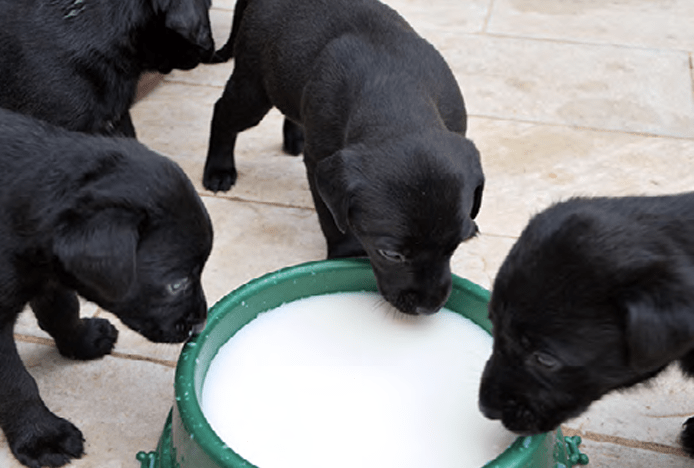Introduction
People who live in the suburbs and own a small acreage often choose dairy cattle or dairy goats as a way to harvest and use their forage. Milk production can reduce the family grocery bill. Goats, especially, help control brush and weeds and keep the area from becoming unsightly.
If you already own a cow or goat, you’ll find information here about caring for your animal and using the milk she produces. If you are still choosing, remember that the capacity of individual dairy cows and goats to produce milk varies greatly.
Choosing and feeding animals
Buy animals from a producer who keeps production records. Choose an animal that has the desired level of production, or a calf or kid from a dam (female parent) that has an acceptable production record. Evaluating production records also gives you some idea of the percentage butterfat and milk protein you could anticipate. In most cases, a long milk production period is more important for family use than very high production. An animal that does not produce much milk and that milks for only a short period after calving often costs more to keep than the value of the milk she produces.
Choose the most appropriate animal to meet family needs, using the pasture supply you have available. A big cow (such as a Holstein) eats more than a smaller cow (such as a Jersey). A goat requires less forage than any cow. To estimate forage needs, a milking animal eats about 3 percent of her body weight in air-dry feed (hay) every day. For example, a 1,000-pound cow needs 30 pounds of hay or pasture dry matter per day.
A well-fed animal produces more milk than one fed poorly. In addition to forage, a cow may need supplemental grain or purchased feed daily for highest milk production.
There is much published material on feeding dairy animals. Consult your local OSU Extension agent, feed supplier, and others for advice on your specific situation.
Breeding
Breed cows or goats to calve (or kid) approximately every 12 months. You may breed them to your own or a neighbor’s males, or you can be more sure of top quality by using an insemination service. Semen and insemination services are available through several businesses. Using their service ensures superior, disease-free semen, and frees you from needing to keep a male. Your local OSU Extension agent can give you contact information for the semen services in your area.
Using the milk
One problem of keeping a family cow or goat is that there is often more milk than the family can use. An option is to sell this surplus. There are provisions in the law that allow owners of not more than two producing cows or nine producing goats or sheep to sell their surplus milk from their site of production or premises (for example, their home). Before planning to sell, however, contact the Oregon Department of Agriculture division of food safety.
To sell fluid milk commercially (for example, to a grocery store), the producer must be licensed and must meet sanitation and structural requirements for the milking area and milk room to ensure high-quality, safe milk. Unless you can meet these requirements, you will have to find other ways to use surplus milk. Here are a few suggestions to safely use milk at home.
Fluid milk
Fluid milk is the simplest and most obvious way to use surplus milk. All milk, even from your own cow or goat, should be pasteurized. Even if your cows or goats are tested and known to be free of brucellosis or tuberculosis, milk can be a dangerous medium for the transfer of other disease organisms such as E. coli, Listeria, Campylobacter, and Salmonella.
We are all exposed to messages for and against consuming raw milk. Finding correct answers online can be challenging due to how much misinformation is posted there. The authors of this publication encourage readers to search for information from a balanced, research-based source. A good place to start is CDC
Milk also can transfer diseases from one person to another, such as from the milker to the consumer. Typhoid fever, septic sore throat, paratyphoid fever, scarlet fever, and gastroenteritis can be transferred in milk. All of these organisms are readily destroyed by pasteurization.
You can buy small, commercial pasteurizers, or carefully heat your milk to 165°F for a minimum of 15 seconds. Pasteurization does not affect the major nutrients in milk. Store pasteurized milk in a refrigerator until used. Do not store or process milk in direct sunlight, since this causes an off-flavor and nutrient loss.
Cleanliness in all phases of milking and milk handling is important. Wash churns, separators, and other milk handling equipment thoroughly and sanitize them with chlorine (bleach) or iodophor (iodine) solution. These are available from most farm or dairy supply stores or mail order firms. Follow instructions on the container.
As with other household and farm chemicals, store sanitizer concentrates out of reach of children, and use the sanitizers only as directed.
Making butter at home
You can make high-quality butter from pasteurized sweet cream. Do not make butter from old cream or cream that has soured, as it exhibits a strong off-flavor and does not keep well. Save the well-cooled cream skimmings for up to 2 days before churning. Churning uses mechanical means to aerate, dash, or agitate the cream until the tiny globules of milk fat in the cream adhere to each other and form butter granules.
Butter granules form best when the cream is at 54 to 58°F in summer and 58 to 62°F in winter. Stop churning when the butter granules are approximately pea size. Remove the granules of butter from the buttermilk and rinse them with water that is about the same temperature as the buttermilk or slightly cooler. Drain the water, and add salt at the rate of 1 tablespoon to each pound of butter. Then, work the butter with a paddle until the salt is evenly distributed and the last buttermilk is extracted.
Since goat cream does not separate from milk by itself, you’ll need to use a cream separator to make goat butter.
Homemade yogurt
For 3-plus quarts of yogurt, prepare the yogurt base in a 4-quart saucepan or double boiler:
- 3 quarts fresh, pasteurized whole milk or nonfat milk
- Add 1½ cups nonfat dry milk or 1 can evaporated milk (optional, improves consistency)
- Heat the milk to 110°F. Inoculate the milk with approximately ½ cup plain commercial yogurt or your own yogurt starter. Pour into clean, sanitary glass jars or plastic cottage cheese cartons.
- Set the yogurt containers on a tray in the oven for incubation at 110°F (permissible range is 100 to 115°F). Turn the oven on to the lowest temperature to help maintain the desired incubation temperature.
- After 4 hours, start checking the temperature every hour, turning the oven on or off to maintain a temperature as close to 110°F as possible. Do not exceed 115°F or the culture will be inactivated. When the yogurt base coagulates and reaches the consistency of commercial sour cream, refrigerate immediately.
Try to avoid excessive vibration of the yogurt base in the late stages of incubation and when transferring to the refrigerator. This helps ensure a smoother, more custard-like consistency.
You can also buy good home-yogurt makers that simplify the process.
Yogurt should keep for 1 to 2 weeks, depending on the degree of care exercised in making it. Use of wellcleaned, sanitized containers greatly aids shelf life.
Cheese
You can make a number of different types of cheese at home. You can find many home cheesemaking recipes on websites and in books available in most bookstores. It is often best to start with fresh cheese such as chèvre and queso fresco, and then with experience move on to aged cheese such as cheddar. Remember that fresh cheese must be made with pasteurized milk while cheese aged for over 60 days can be made with raw milk.
Sanitation is essential to obtain good-flavored cheese of all types. Starter cultures, rennet, and other cheese-making supplies are now readily available from brew supply stores or online.
Licensed (artisan) dairy processing
You can sell raw milk if you only have a few animals. But, if you become interested in producing and selling other dairy products, then your facility must be licensed. For more information on how to start up a licensed dairy processing facility, see the Oregon State University Extension Service publication Permits and Licenses Required for Startup of Artisan Cheese Plants in Oregon
Animal feed
You can use excess milk for animal feeds. A few suggestions:
- Calves or kids. Milk is, of course, the natural food for calves or kids. It should be limited to 8 percent of the body weight of young calves or kids, to avoid digestive disturbances.
- Pigs. Skimmed milk, buttermilk, and whey are excellent feed.
- Chickens. Milk is an excellent feed supplement for chicks. However, it is somewhat laxative and may cause wet litter when birds are confined.
- Other animals. You can feed milk to a variety of young animals such as puppies, lambs, foals, and kittens. If puppies develop diarrhea, stop feeding them milk until the stool is normal.

